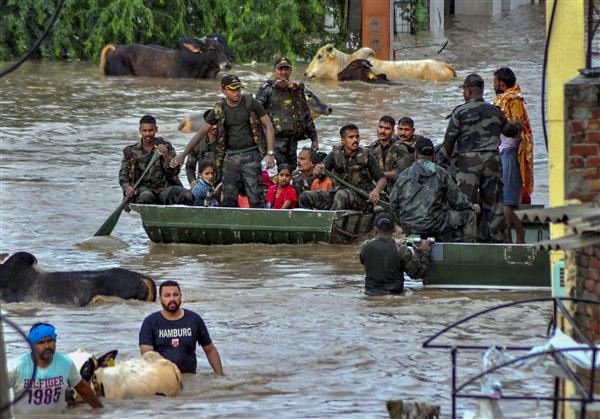Prime Minister Narendra Modi has assured the Chief Ministers of the flood-hit northern states all help from the Centre as Army units and NDRF teams launched rescue and relief operations in the affected areas.
Himachal Pradesh, Punjab, Uttarakhand and Haryana are reeling under the monsoon fury as incessant rains continue to batter the region for the third day in a row.
The Army rescued 910 students and 50 others from a private university in Punjab after it was flooded with water due to heavy rains and NDRF teams have also been deployed in the affected areas, according to an official statement issued on Monday.
The civil administration in Punjab and Haryana had earlier sought help for the rescue operation from the Army, which sent the Flood Relief columns of Army’s Western Command to assist the administration in the flood affected areas of the two states.
“After assessing the situation on ground, the rescue and relief columns reached the affected areas. The rescue team along with the Army engineer detachments worked throughout the (Sunday-Monday intervening) night to evacuate the stranded people and helped to prevent breaching of canals by the flood waters,” it said.
A total of 38 National Disaster Response Force (NDRF) teams are carrying out rescue and relief operations in Punjab, Uttarakhand and Himachal Pradesh.
Prime Minister Narendra Modi on Monday spoke to Uttarakhand Chief Minister Pushkar Singh Dhami and Himachal Chief Minister Sukhvinder Singh Sukhu and inquired about the extent of the damage caused to life and property due to excessive rainfall in the states.
PM @narendramodi spoke to senior Ministers and officials, and took stock of the situation in the wake of excessive rainfall in parts of India. Local administrations, NDRF and SDRF teams are working to ensure the well-being of those affected.
— PMO India (@PMOIndia) July 10, 2023
The Prime Minister enquired the condition of roads including the Char Dham Yatra, the condition of agriculture, farmers and crops and the conduct of the Kanwar Yatra.
As the rain across the northern parts of the country has killed over 20 people, as well as caused landslides and flash floods in the region, the NDRF’s 15 teams are deployed in Punjab, 12 in Uttarakhand and 11 in Himachal Pradesh.
Some reserve teams of the NDRF are also ready to meet any challenge in an emergency situation in Delhi where the Yamuna river is flowing at 203.58 meters and is expected to reach 205.5 meters by tomorrow morning.
“Some more places may face problems as a few reservoirs will be opened tomorrow. NDRF will be deployed accordingly to deal with any challenge,” NDRF DIG Mohsen Shahedi told news agency ANI.
Some rescue operations have also been undertaken by the NDRF personnel in each of these three states– Punjab, Uttarakhand and Himachal Pradesh. “Rescue operations were conducted in almost each state, and it continued the whole night.”
“Relief materials have also been provided at many places. The relief materials have been provided to people stranded at some safe locations. These materials were provided to these people with the help of state administration and state agencies,” Shahedi told ANI.
The weather office has forecast that heavy rain will continue over most parts of north India including Delhi, Himachal Pradesh, Uttarakhand, Uttar Pradesh, Punjab, Haryana, and Rajasthan for the next two days.
In Himachal Pradesh, landslides and flash floods, triggered by incessant rain, damaged houses, structures and paralysed normal life. Some shops and vehicles were also washed away in flash floods in Manali, Kullu, Kinnaur and Chamba as all major rivers such as Ravi, Beas and Satluj are in spate.
The Himachal Pradesh Government has closed all the government and private schools and colleges in the state for two days (July 10 and 11).
Landslides and flash floods were reported in neighbouring Uttarakhand as well, with rivers crossing the danger mark.
A red alert has been issued for Kathua and Samba districts of Jammu and Kashmir. However, the Amarnath Yatra resumed on Sunday after remaining suspended for three days.
The IMD said an interaction between a western disturbance moving in from the Arabian Sea and monsoon winds from the Bay of Bengal have had the impact of a double whammy resulting in torrential rains of unprecedented intensity.




















